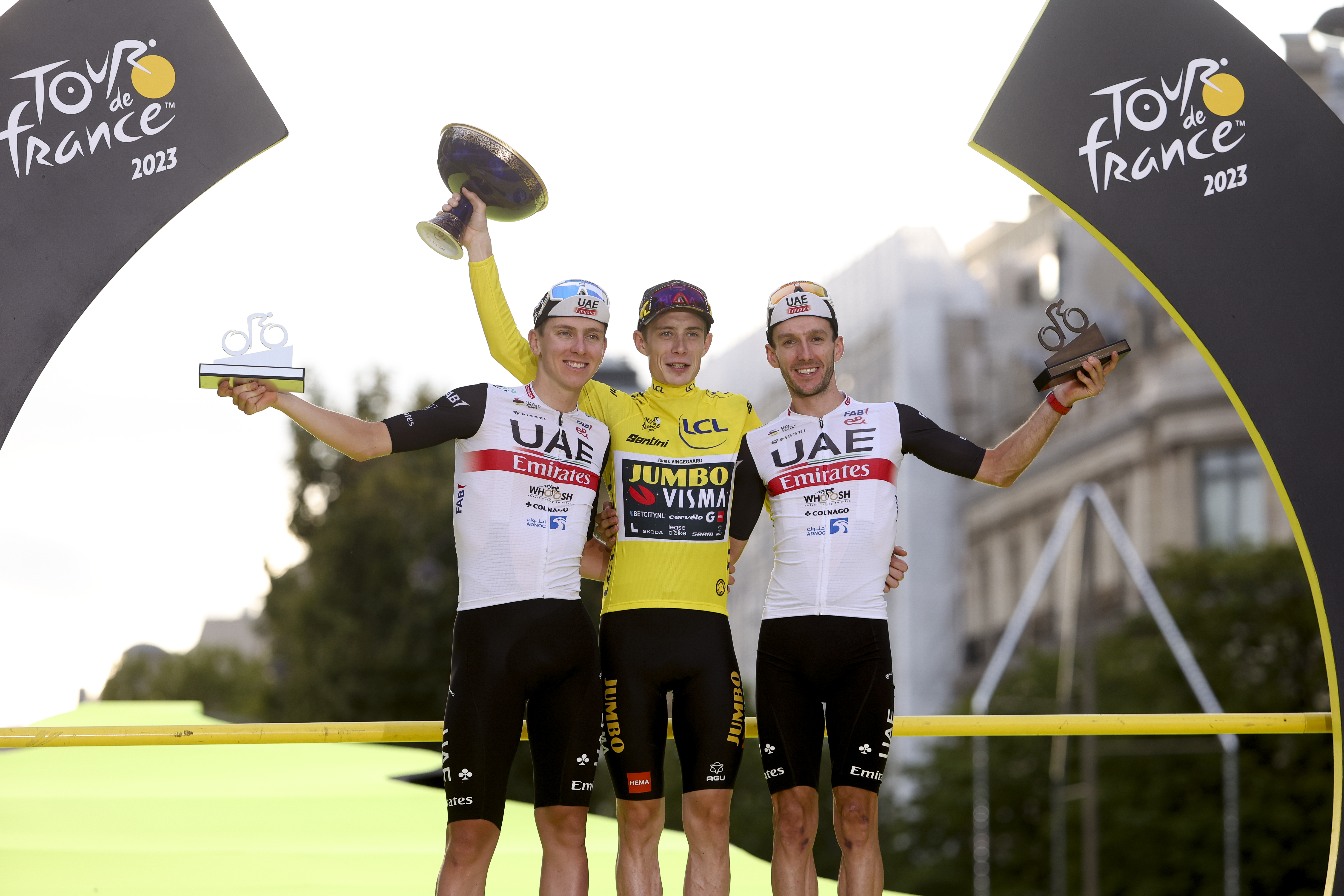
The Tour de France 2024 route includes five summit finishes, 59km of individual time trialling, and gravel sectors on stage nine.
It begins on the 29 June, and finishes on the 21 July, three weeks later.
The race will begin in Italy for the first time, with stages from Florence to Rimini, Cesenatico to Bologna and Piacenza to Turin. It will mark 100 years since the first Italian winner of the Tour, Ottavio Bottecchia.
Another first is that the Tour will not conclude in Paris for the first time ever, due to the 2024 Paris Olympics, with the final stage coming in Nice. It also means that for the first time since 1989, the final stage will be contested, in a time trial.
On the way, the race tackles the Alps, the Massif Central and the Pyrenees, including four summit finishes at Pla d'Adet, the Plateau de Beille, Superdévoluy, Isola 2000 and the Col de la Couillole, and 59 kilometres of time trialling across stages seven and 21.
There are 14 gravel sectors on stage nine from Troyes to Troyes, totalling 32km, with six packed into the final 35km in what could be a decisive point of the race. The longest is 4km.
With the final day a hilly time trial in Nice and not the usual procession in to Paris, it is hoped that the race will be alive right to the end of the race. The whole final week, in fact, will be crucial for general classification, with four of the six days potentially decisive.
According to the race organisers, there are eight sprint opportunities along the way, although some are not as straightforward as others, with a breakaway sure to contest some of them. Mark Cavendish will be looking forward to Saint-Amand-Montrond on stage 13, where he won in 2013, and Nîmes on stage 16 especially, where he won in 2008.
Last year, the race was dominated by Jonas Vingegaard (Jumbo-Visma), who crushed all of his competition, including Tadej Pogačar (UAE Team Emirates), on the stage 16 time trial to Combloux and stage 17's summit finish in Courchevel.
Tour de France 2024 route: stage summary
Full Tour de France 2024 route map

Tour de France 2024 route week one
The 2024 Tour de France begins how it means to go on, with a lot of climbing. Stage one begins in Florence, and includes 3,800m over 205km, the most ever in an opening stage, according to race director Christian Prudhomme.
The second stage is also hilly, starting from Marco Pantani's hometown of Cesenatico, finishing in Bologna through Emilia-Romagna. It copies the route of the Giro dell'Emilia, including the final climb of San Luca - 1.9km at 10.6 per cent - which is tackled twice.
There is a chance for the fast men on stage three, which covers 225km from Piacenza to Turin.
Stage four sees the race finally reach France, via the Alps. The Sestriere, the Col de Montgenèvre and the Col du Galiber are all tackled before a descent to Valloire.
Stages five and six, to Saint-Vulbas and Dijon, should be sprint opportunities, but the fast men could be ambushed.
The race's first individual time trial comes on stage seven, but it will be a technical affair as opposed to a pure rouleur's course, before stage eight should be another chance for the sprinters.
Stage nine could be the highlight of the opening week, and is certainly something new, using the gravel roads of the Champagne region to mix things up. The 32km of gravel across 14 sectors is inspired from the Tour de France Femmes 2022, which used two of the same tracks; it is the biggest use of gravel at the Tour to date.
Tour de France 2024 route week two
After a rest day in Orléans, the closest to Paris the race gets in 2024, there are four stages which head south towards the Pyrenees.
Stage ten will surely be a sprint stage, but the winds could blow, as they did in 2013, when Cavendish won, while stage 11 is a return to medium mountains. The stage to Le Lioran is similar to the one which Greg Van Avermaet triumphed on in 2016, taking the yellow jersey in the process. 4,500m of climbing will make this a tough test for everyone.
It's back to sprinting or breakaways on stages 12 and 13 to Villeneuve-sur-Lot and Pau, respectively, with the latter looking more nailed on for a bunch finish.
Stage 14 is the first Pyrenean test, finishing atop the Pla d'Adet, which marks Raymond Poulidor's victory up there 50 years ago; it follows the Col du Tourmalet and the Hourquette d’Ancizan in just 152 km.
After that, the climbing does not stop. On Bastille Day, Catorze Juillet, the race heads from Loudenvielle to Plateau de Beille, in a stage that covers 198 km, with 4,850 metres of climbing. The Peyresourde is tackled first, followed by the Col de Menté, the Col de Portet d’Aspet, the Col de la Core, and Col d’Agnès, before the final test to Plateau de Beille. It will surely help decide the direction of the race.
Tour de France 2024 route week three
A classic transition stage follows the second rest day from Gruissan to Nîmes, which is planned as a sprint stage, but if the winds blow, mayhem could ensue.
Stage 17 is a return to the mountains with a finish in the ski resort of Superdévoluy on the fringes of the Alps, before stage 18 looks set to be a breakaway day as the race travels from Gap to Barcelonnette.
It is the final three days where the 2024 champion will be crowned, however, with two back-to-back summit finishes in southeast France. Stage 19 finishes atop Isola 2000, with the Col de Vars, at 2,120m, before the Col de la Bonnette, at 2,802m, marks the high point of the race, and then there's Isola 2000.
Stage 20 feels like a Paris-Nice penultimate stage, and kind of is, with some of the favourite climbs from the race tackled consecutively. The Col de Braus is first, 10.2km at 6.3 per cent, before the Col de Turini, 20.6km at 5.6 per cent, and then the Col de La Colimiane, 7.6km at 6.8 per cent, and then, finally the Col de la Couillole, 15.7km at 7.1 per cent. That's 4,500m of elevation in just 132km.
However, that is not the end of the race. This year, there is a final day time trial around Nice, not a procession in Paris. The 35km course includes La Turbie, 8.1km at 5.6 per cent, and the Col d’Eze, 1.6km at 8.1%, before concluding on the Promenade des Anglais.
Tour de France 2024 route: stage summary
Stage one: Florence > Rimini (206km)

Today’s route Starting in Florence, the birthplace of legendary Italian cyclist Gino Bartali as well as Renaissance art and architecture, the first stage is a lumpy route travelling east to Rimini on the Adriatic coast.
There are seven categorised climbs on the menu and the first, the 11km Col de Valico Tre Faggi, will top out after just one hour of racing. Then comes a succession of short but difficult climbs, with the final ascent denoting the entrance to the principality of San Marino. From there, it’s a 26km fast downhill race back to the Italian coast.
What to expect
The teams with general classification ambitions might be happy to let a rider who isn’t thinking about Paris take the race’s first yellow jersey – and with it all the attention and obligations – and the sprinters’ teams won’t be working either. But with a yellow jersey up for grabs, there is little chance an excited peloton will let a break go the distance.
It’s a difficult enough day and some outside contenders might have their dreams dashed on day one, but don’t expect any full-gas attacks from the bigger GC riders – there’s no need to fire too many bullets on the opening weekend, however tempting it might be.
Stage two: Cesenatico > Bologna (199.2km)
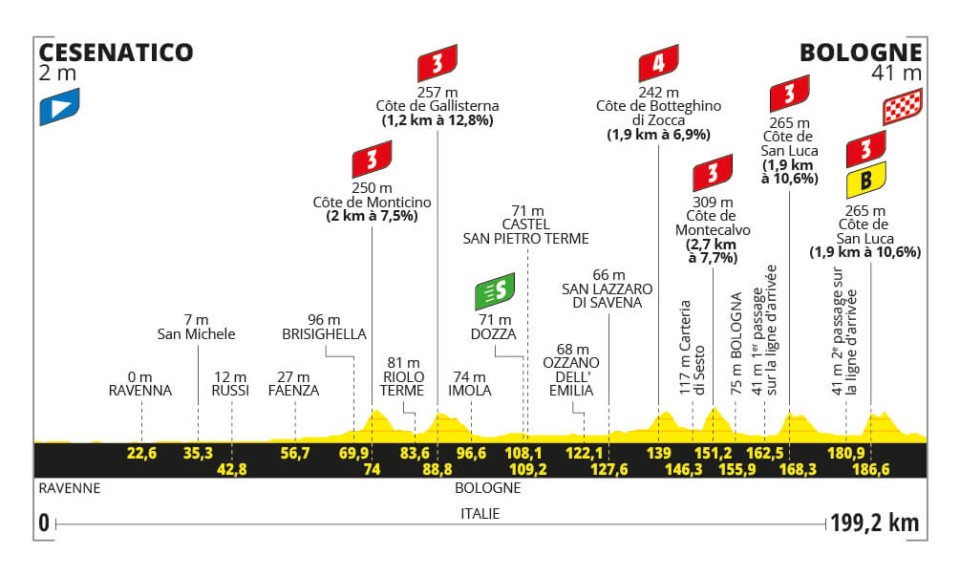
It’s a seaside start in the spa resort of Cesenatico, home to the late Marco Pantani, the last rider to achieve the Giro d’Italia-Tour de France double in 1998. Ironically, a stage that harks back to 'Il Pirata' is mostly flat. There are two little bumps in the first 140km as well as a spin around the Imola racing circuit, the venue of the 2020 World Championships.
Then come two short back-to-back climbs before the peloton arrives in Bologna for two circuits that take in the San Luca climb (1.9km at 10.6%), used as a summit finish in the autumn-held Giro dell'Emilia. Today, however, the riders have 12km over the top of the final climb to get organised for the finale in Bologna.
What to expect
Despite those bumps in the profile, this should be a fairly straightforward stage for a peloton with fresh legs. A group will no doubt go clear but with lots of riders fancying their chances, and with GC riders being wary of losing time through inattention, speed will be high and the break won’t be given much time. The two climbs of San Luca are a perfect launchpad for a Classics rider who thinks they can hold off the bunch, while a sprinter in great form will also think the stage is up for grabs.
Stage three: Plaisance > Turin (230.8km)
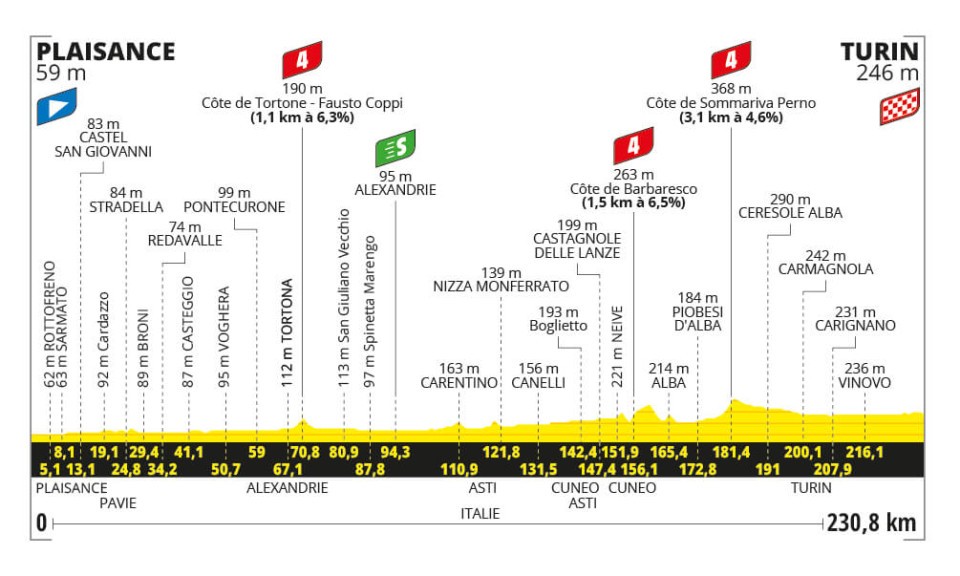
At 230km, it is the longest stage of this year’s Tour, with the whole Tour caravan heading west to Turin. Before it gets to Italy’s fourth most populous city, there’s a passage through Tortona, the town where the iconic Fausto Coppi, a winner of two Tours and five Giri d’Italia, died in 1960 due to misdiagnosed malaria.
Two fourth-category climbs have to be tackled ahead of what will be a fast and largely arrow-straight run-in to Turin for the finale.
What to expect
A doomed breakaway, possibly with just two or three riders, will go clear, but they will know their fate from the moment the peloton lets them loose. Expect one of the lowerranked teams, such as Uno-X Mobility, to be present.
The bunch will make the catch in plenty of time in anticipation of the first mass sprint of the race. A sprint without hiccups is not a foregone conclusion, though, with all the sprint trains fighting for position and the usual first-week nerves and tension often causing crashes at decisive moments.
Stage four: Pinerolo > Valloire (139.6km)
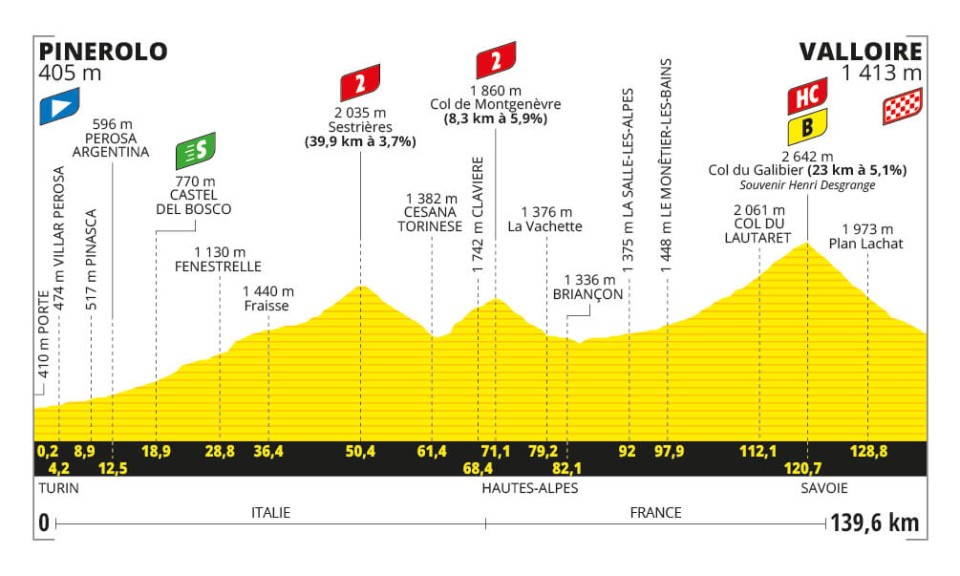
Not since stage two of the 1979 Tour, a time trial to the Pyrenean ski resort of Superbagnères, has the Tour climbed above 1,800m so early in the race.
Given that stage four – which starts in Italy – exceeds 2,000m after only 50km with a passage through Sestrières, and then another taxing test (the Col de Montgenèvre) precedes the mighty Col du Galibier, it’s little wonder this is being labelled as the most difficult start to a Tour on record.
Race organisers have at least resisted the temptation of a summit finish on top of the Galibier, with riders having to descend 19km into the town of Valloire before they catch sight of the finish line.
What to expect A short stage that goes straight up a mountain is the stuff of nightmares for sprinters. Contesting a fast finish yesterday, today they’ll be terrified of a fast start, getting dropped and the broomwagon looming large behind them. The break will form on the first climb to Sestrières and only once that has formed will the bunch sit up and take a collective breath.
The action will hot up again for the GC riders in the thin air over the top of the fabled Galibier, but with a long, and in the most part not too technical, descent to Valloire there is time for mountain domestiques to chase back to their leaders and help close any gaps.
Stage five: Saint-Jean-de-Maurienne > Saint-Valbus (177.4km)
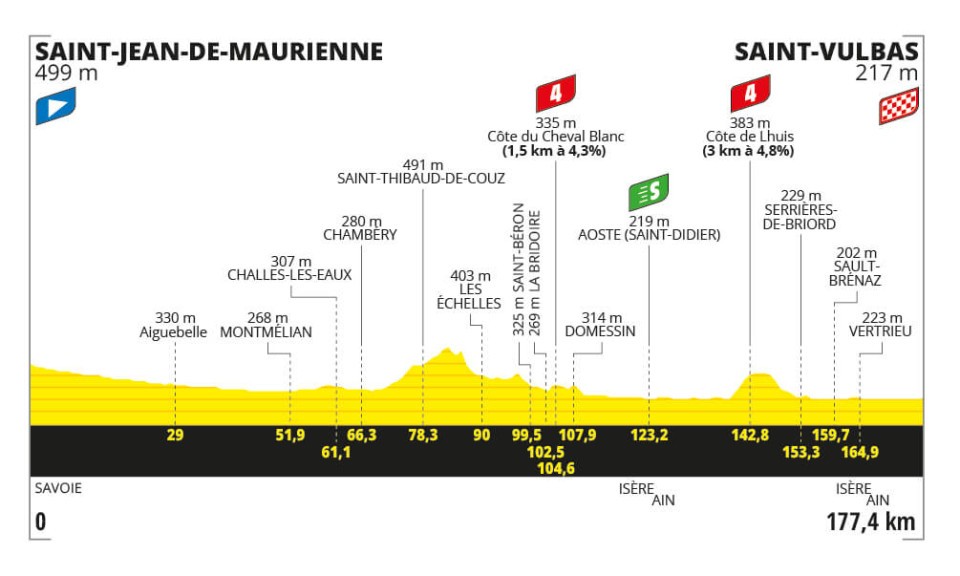
Saint-Jean-de-Maurienne, a frequent staging post of the Tour, is the start town for the peloton’s speedy exit towards central France. The unclassified, long but shallow Col de Couz comes just before the midway point, and then there’s the climb of the Côte de Lhuis (4.4km at 4.2%) 34km before the finish.
The river Ain is crossed inside the final few kilometres, with the sprinters expecting their glory in the sleepy, tiny village of Saint-Vulbas.
What to expect
It’s only day five, but already fatigue will be creeping into riders’ legs, especially after the efforts of the previous day in the Alps. The GC teams will therefore be more than content to let the sprinters control the day, and thus the breakaway riders will have to fight hard to resist the collective pull of the fast men and their brothers in arms.
The climb of the Côte de l’Huis does at least offer something for the escapees to launch a move on, but they would have to put in an almighty time trial effort to hold the charging peloton at bay.
All the sprinters should make it over the final categorised climb, although don’t be surprised to see one or two sprint teams pushing hard on the ascent in an effort to distance some rivals.
Stage six: Mâcon > Dijon (163.5km)
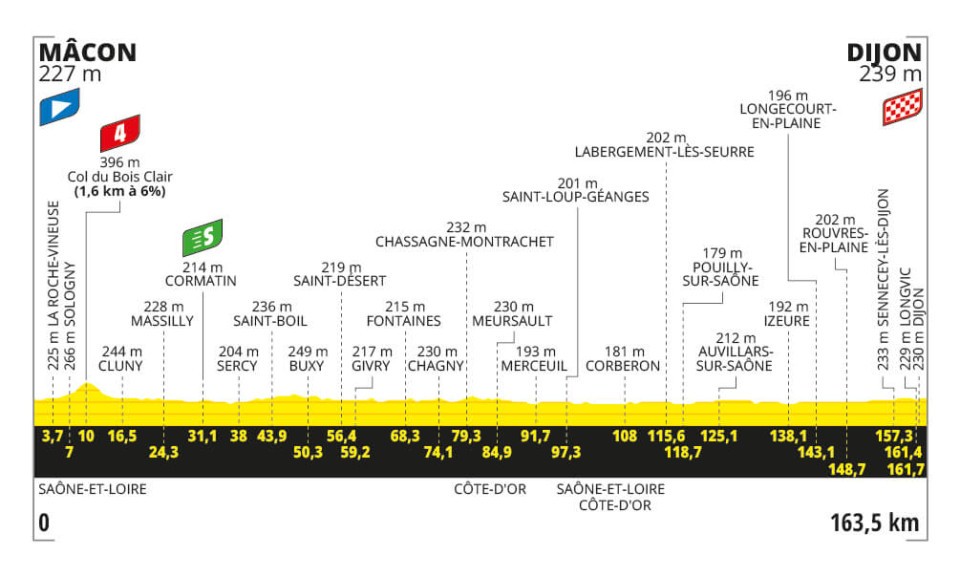
From Mâcon, a frequent host town of the Critérium du Dauphiné, the race goes north through the Burgundy wine region, and specifically embarks on its own Route des Grands Crus. The most famed red wine from this area is produced from pinot noir grapes and is known for its dry texture, while the best white wines are made from chardonnay grapes.
The journey through the vineyards is a flat one before an 800-metre straight finale in Dijon, hosting its first Tour finish since 1997. Whoever is victorious might just get to experience one of the region’s famous wines. Just don’t tell Visma-Lease a Bike’s boss Richard Plugge, who criticised Groupama-FDJ for drinking alcohol on a rest day last year.
What to expect
The race might be heading towards Paris, but this is no stage 20 last-chance saloon for a big breakaway group. Instead, the sprinters’ teams will only let a break go - probably a small one - once they’re happy they can control it. That means sitting on the front of the bunch and keeping them at a comfortable distance before reeling them in towards the end.
The race’s first time trial is tomorrow so the GC contenders will be taking it easy, and no doubt warming down on their TT bikes as soon as they’re safely back at their buses.
Stage seven: Nuits-Saint-Georges > Gevrey-Chambertin ITT (25.3km)
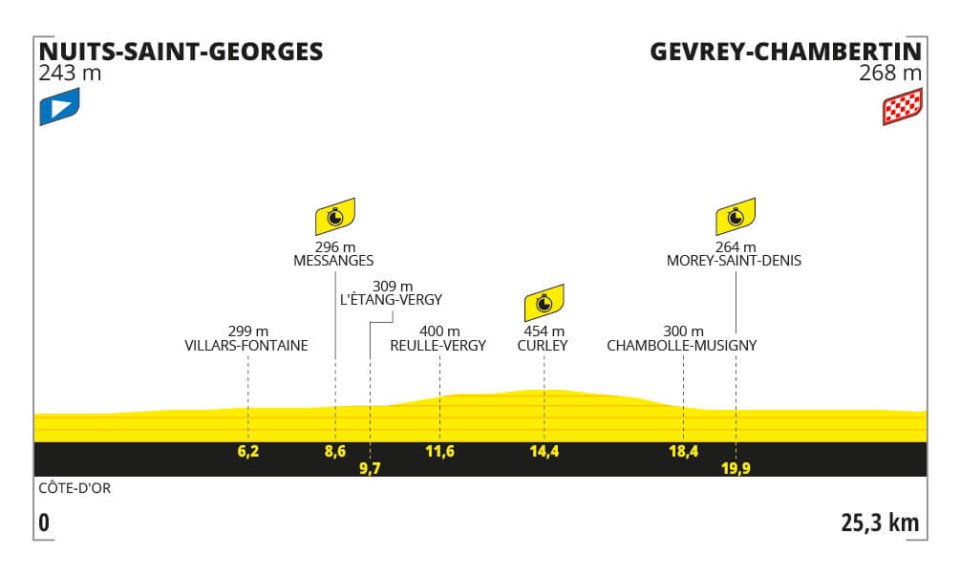
The race remains firmly nestled among the vineyards in the east of the country, with a 25km time trial between two wine-making villages. The route’s general direction is set to north, although it will deviate west to take in the Côte de Curtil-Vergy. However, coming at the halfway point of the stage, and being relatively tame at just 6.5% for 1.5km, riders won’t be ditching their road bikes to tackle the ascent.
What to expect
Usually, the differences between the main general classification riders aren't huge on flat courses of less than 20 miles, but TT world champ Remco Evenepoel, the strongest TTer of the GC riders, has made a habit of gaining between 30 and 60 seconds on rivals on courses like this. GC riders on top of their game with good aero packages are hard to beat, even by TT specialists, so the gaps won’t be huge.
Do expect Giro’s Aerohead TT helmet to once again cause a stir, as millions of people across the world tune into a cycling race for the first time this year and shout, "What’s that on their heads?!" at the television.
Stage eight: Semur-en-Auxois > Colombey-Les-Deux-Églises (183.4km)
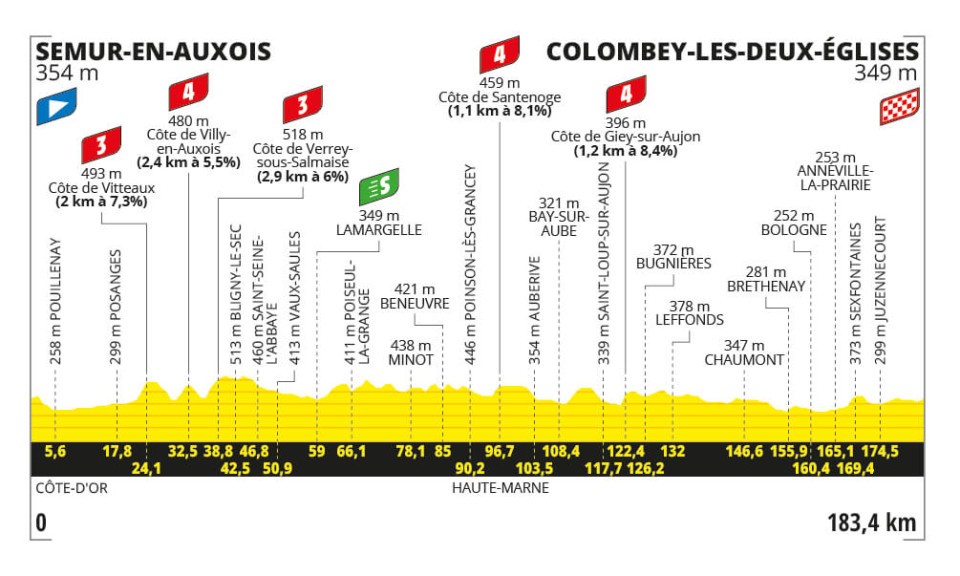
We’re just a stone’s throw from Dijon – teams will no doubt be enjoying the limited travel times before and after these stages. Today the race departs from Semur-en- Auxois, which has a population of just 4,200.
The stage begins with a flurry of three categorised climbs in the first 40km, then three more just after the halfway point. The undulating parcours continues late into the stage with a final small climb 17km from the end, before a finishing kilometre that averages 3%. The average speed over such terrain will help shape the result. If it’s a steady day, all the sprinters will fancy their chances; if it’s fast, it will favour the fastmen in good form.
What to expect
None of the climbs are long or hard enough to affect the order of the GC, but if a big breakaway goes clear, controlling the stage will be a challenging task for the sprint-focused teams. If this stage were later in the race the odds would be stacked in favour of a big break. But there will still be plenty of fastmen in the bunch, thus ensuring their teams take charge. So expect a small break brought back within 15km of the finish.
Stage nine: Troyes > Troyes (199km)

The origins of this route can be traced back to 2022, the year the Tour de France Femmes was reborn. On stage four of the race, the women’s peloton rode across four lots of white roads, with Marlen Reusser eventually taking the win.
For the men this year the challenge is even greater, with 14 gravel sections totalling 32km to be tackled over the course of today's circular route – albeit with different start and finish locations in the city of Troyes. The first half of the stage is a little hillier, but the four fourth-category climbs will be inconsequential compared to the gravel sectors and the fight for position that will inevitably happen before each one. The final half-a-dozen gravel sectors are all grouped together in just 24km and it’s a day for constant attentiveness and high tension.
When the route was announced, Visma-Lease a Bike’s boss, Richard Plugge, said, “Gravel, for me, is not necessary in a race such as this,” and Soudal-Quick Step’s always outspoken boss Patrick Lefevere simply said: “I’m not a fan of it.”
The reason for their disdain is clear: a stage like this – ditto when the Tour traverses the Paris-Roubaix cobbles – can severely dent a rider’s overall ambitions, with a badly timed mechanical or slip on the uneven surface often proving more damaging than a bad day in the mountains.
What to expect
When the TdF Femmes undertook a varied version of this stage two years ago, the differences between the overall contenders were minimal, and on a similar-looking course at the Giro d’Italia this May, time gaps were nil.
But today is a unique opportunity for GC riders confident of their abilities to put their team-mates on the front and their rivals under pressure. Splits are likely to occur, and as soon as they do those at the front will seize the opportunity to push on and open up the gaps. Speed will be high not only over the gravel but in the approach to each section as the stronger teams get their leader to the front and maintain a high pace to keep them there. A break is still likely to go clear, and perhaps a large one. That group, as well as the peloton, will then fragment later in the stage.
Keep an eye on the weather forecast, as wind and rain will only heighten the risk and therefore the tension in the bunch. When that happens, time gaps can be significant.
Stage 10: Orléans > Saint-Amand-Montrond (187.3km)
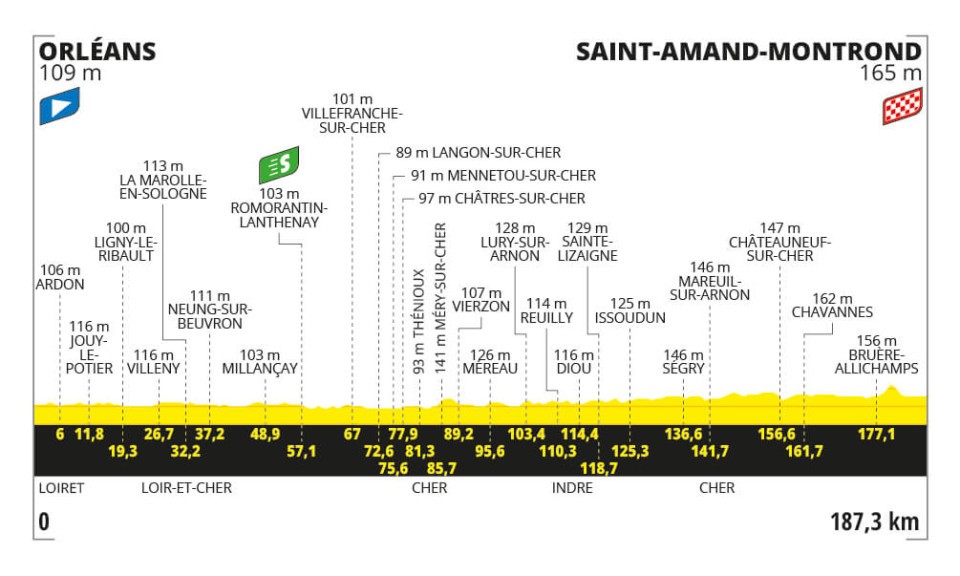
Beginning in the city of Orléans – yesterday's rest-day location – riders head due south, with not a single categorised climb on today’s parcours.
But with three changes of direction in the final 30 kilometres taking riders onto exposed roads in a region famed for its wind, a bunch sprint in Saint- Amand-Montrond, the hometown of Soudal-Quick Step’s non-competing Julian Alaphilippe, could be in doubt.
What to expect
The lack of any elevation makes it an unappealing stage for a break, so today might turn into one of those long days where one rider from a smaller team – step forwards TotalEnergies and Arkéa-B&B Hotels – spends several hours off the front with only the TV moto for company.
If wind is forecast – expect teams to be analysing the weather intently in advance – you’ll see the pace increase as teams of the GC riders and the sprinters are all told to get to the front at the same time. This not only increases speed, but nerves too. If the wind is blowing, expect Classics riders hitting the front to line it out and create the echelons. The sprinters will be alert, and are used to fighting for position, it’s the GC riders with no big burly team-mates you need to worry about. If this happens, the break's lead will drop like a stone and they’ll be caught and dropped before they know it.
Stage 11: Évaux-Les-Bains > Le Lioran (211km)
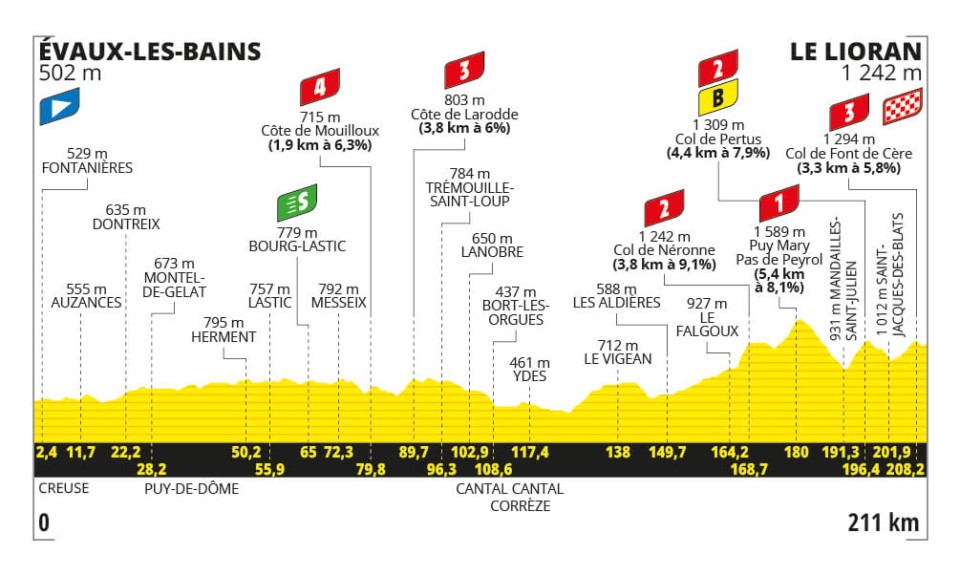
It’s a relatively benign opening 150km as the peloton crosses through the majestic Massif Central. But the calmness will almost definitely precede a storm with four categorised climbs jammed into the final hourand- a-bit of racing that features a gradual rise in elevation to the finish line at 1,242 metres above sea level.
The Col de Néronne (3.8km at 9.1%) is a mere warm-up to the volcanic first-category Puy Mary where the final two kilometres average 12%. A fast descent is followed by the Col de Pertus (4.4km at 7.9%) with some bonus seconds over the top, then the final climb of the Col de Font de Cère (3.3km at 5.8%). The finish line is 2.8km further on from the summit although not categorised as a climb in its own right.
What to expect
It’s likely there will be a big battle to get into the day’s break, but not until after the intermediate sprint at 56km. As soon as the categorised climbs begin, so will the attacks.
With 4,350m of elevation gain, it’s one of the most climb-laden stages of the entire race, and the roads of the Massif Central are not as wide, straight or smooth as the rest of France. All of which means the GC riders and their hard-working team-mates need to be switched on all day. Tadej Pogačar’s UAE Emirates team-mates are most likely to be on the front today.
Stage 12: Aurillac > Villeneuve-sur-Lot (203.6km)
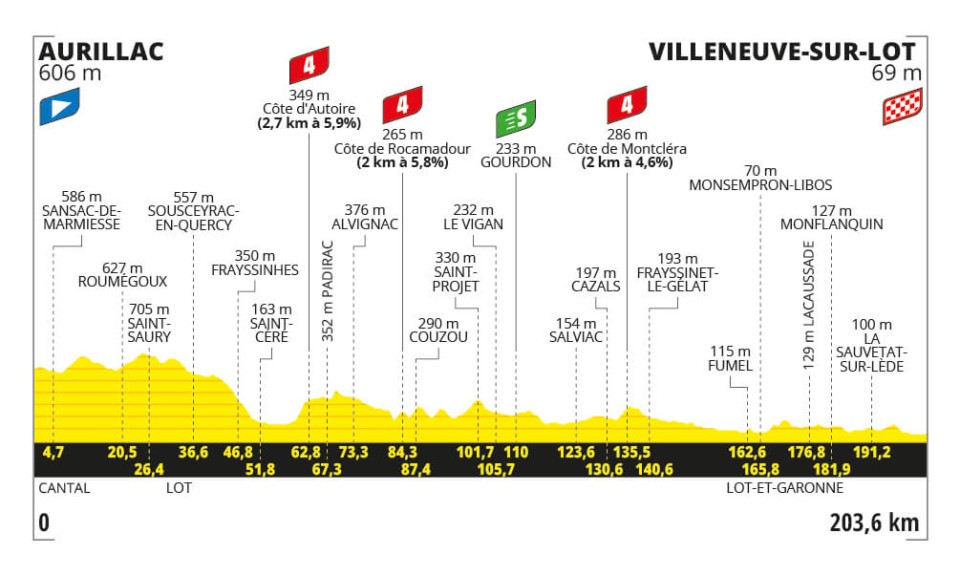
Crossing west across central France, there are just three classified climbs on today’s route, but all are fourth-cat climbs and are likely to pass without the slightest shift of rear mechs for anyone safely tucked away in the peloton. The second climb of Côte de Rocamadour was used in the penultimate stage of the 2022 Tour, a time trial won by Wout van Aert. This year, however, the race passes over the summit from the opposite side.
The latter half of the stage profile sees it gradually smooth itself out, and even the presence of a slight rise inside the final 10 kilometres won’t be enough to deny the sprinters.
What to expect
With more than 2,300m of elevation gain throughout the stage, there’ll be many riders hoping that the undulating nature favours the break. That said, the climbs themselves are relatively insignificant; from start to finish, there is an overall loss of 537m, meaning there will be plenty of freewheeling in the bunch and therefore effort saved. It’s difficult to see how an escapee could triumph, unless there is a botched or incohesive chase from the peloton.
With sprint opportunities diminishing – there are only two left after this one – the sprint teams will be at the head of the peloton as soon as the flag drops, keeping the break in check and then preparing for a showdown. Curiously, though, on the race’s only two previous finishes in Villeneuve-sur- Lot, it has been a sole rider from the breakaway that has prevailed.
Stage 13: Agen > Pau (165.3km)
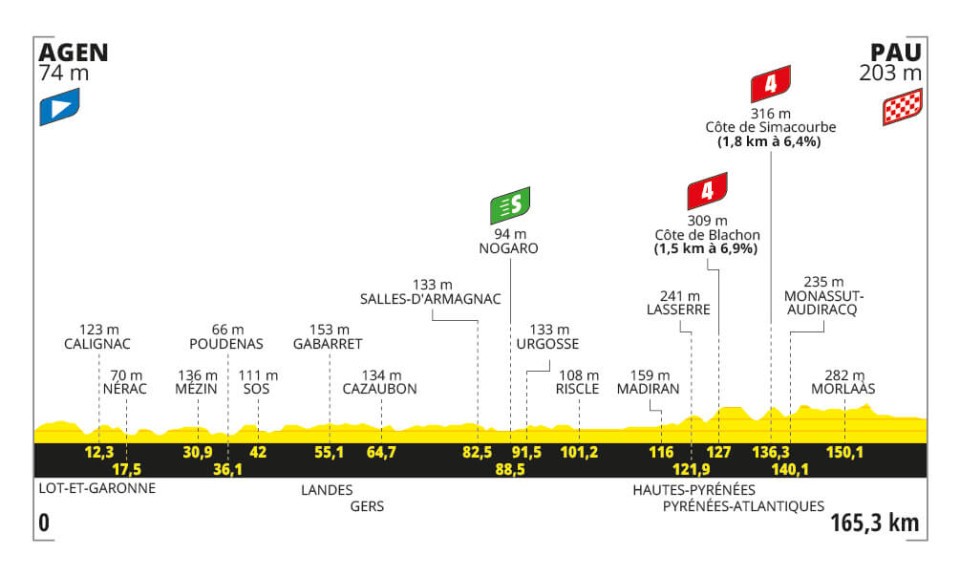
Beginning from Agen, a small city that last featured in the race in 2000, the Pyrenees in the distant background will gradually get closer throughout the day.
It’s an undulating route south with a pair of fourth-category climbs in the final quarter, but their gradients are tame and a descent precedes the fast finish in Pau, the third most-visited city in the history of the Tour.
What to expect
The hilly terrain throughout, with just under 2,000m of climbing in total, is helpful to the breakaway, as is the size of the roads. This is no sweeping route on wide, straight roads, but a more winding route on narrower roads. This can favour the break if the peloton can’t sweep along at 54kph when they need to reel them in. The two climbs, the Côte de Blachon and the Côte de Simacourbe, may also disrupt proceedings if they tempt riders into attacking or see a key sprinter momentarily dropped. It’s not out of the question that a break could spoil the sprinters’ plans.
Look out for the intermediate sprint at 88km. If the sprinters’ teams want to keep things together in order to contest the points, expect a frantic hour-and-ahalf of racing as every attempt at an escape gets chased down.
Stage 14: Pau > Saint-Lary-Soulan Pla d'Adet

As with most Pyrenean stages, today starts outside the big mountains with their valley roads, in a city on the periphery. For the 75th time, Pau is where the stage begins, resulting in a gradual incline for the first 70km until the foot of the Col du Tourmalet, site of the intermediate sprint.
Ascending the most-climbed mountain in Tour history from its west side (the longer of the two), the peloton then have two climbs to come: Hourquette d’Ancizan (8.2km at 5.1%) – a modern-day regular first used in 2011 and now featuring for the sixth time – follows the Tourmalet, before a summit finish at Pla d’Adet. At just over 10km, the opening stretches regularly exceed 10%, but the severity lessens towards the top. The climb was last visited a decade ago when a young Rafał Majka triumphed.
What to expect
Being the first mountain summit finish of the race, riders on the hunt for the maillot jaune don’t need to be reminded how crucial stage 14 is to the overall result of the race. Lose contact with the lead group on one of the three cols, and a rider will be waving au revoir to their chances.
A big breakaway group will form after the intermediate sprint, with riders from the big GC teams among them, ready to drop back later in the stage to assist their appointed leaders.
The peloton will take a breather on the Tourmalet - relatively speaking - with the team of the highest-placed GC rider (the yellow might be on the shoulders of a breakaway rider) asserting control. Speed will be increased on the Hourquette d’Ancizan and a few big-name riders will be gapped. They will no doubt chase back on, but in doing so will know that they’re going to be dropped again on the final climb when UAE, Visma or Ineos sit on the front and ride at an uncomfortably high pace. The question we’re all asking is: when will the likes of Tadej Pogačar or Primož Roglic make their move? Early or late on the climb?
Stage 15: Loudenvielle > Plateau de Beille
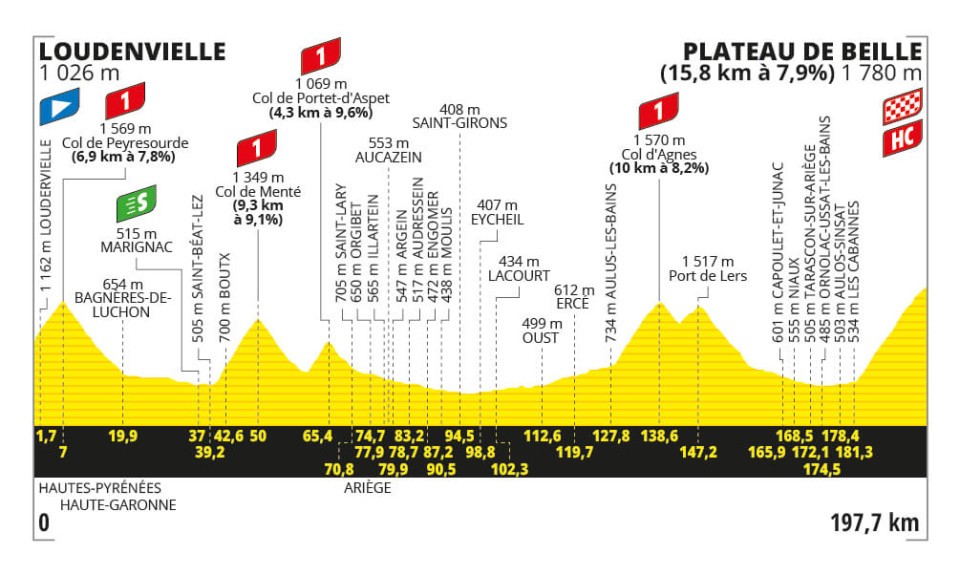
Imitating a portion of the Raid Pyrénéen route, stage 15 crisscrosses five of the region’s peaks from west to east, starting with an ascent of the Col de Peyresourde as soon as the flag drops.
The Col de Menté (9.3km at 9.1%) and Col de Portet-d’Aspet (4.3km at 9.6%) are next, but there’s a 60km lull before the riders reach the Col d’Agnes (10km at 8.2%). The following short climb of the Port de Lers is not classified but could catch riders unaware. However, after that there’s a 35km descent for any dropped riders to regroup before the formidable Plateau de Beille, a 15.5km slog that averages 7.9%.
What to expect
Riders will be warming up on their turbos today, getting themselves ready to react to the immediate attacks from those wanting to be in the break. Expect plenty of French faces in the large break that will form, each of them hoping to become the first French stage winner on Bastille Day since Warren Barguil in 2017.
With a lot of nothingness separating the third and fourth climb, the race will no doubt enjoy some calm in that middle section before stirring back to life on the penultimate col. If there’s no GC threat nestled among the escapees, they have a good chance of going all the way, albeit in ones and twos up the final climb.
The yellow jersey group is likely to bide its time, but attacks are guaranteed on the Plateau de Beille. There’s also another contest to keep an eye out for: this is a huge day in the King of the Mountains competition with 10 points for the first rider over the cat-one climbs and 20 on the finish line.
Stage 16: Gruissan > Nîmes (188.6km)
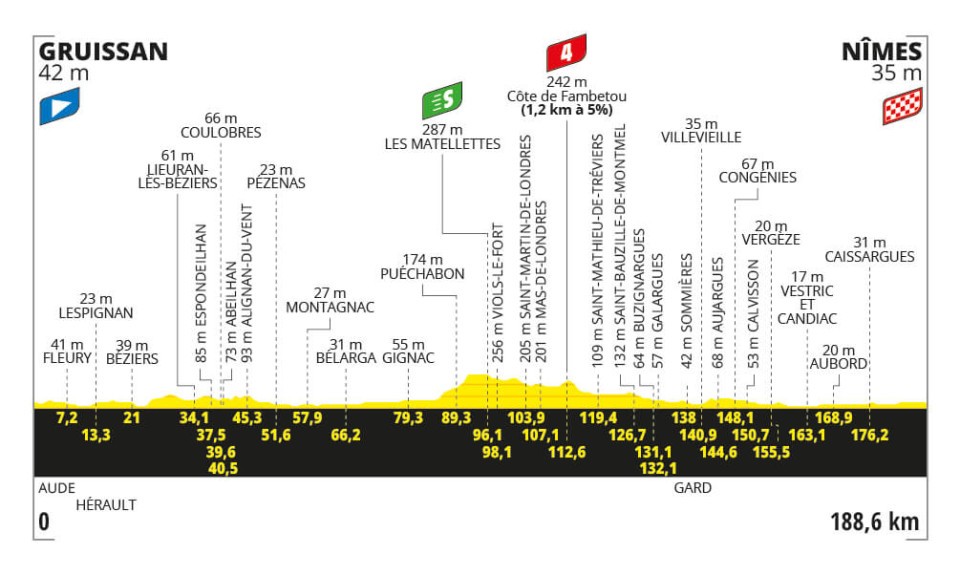
Gruissan, a beautiful circular coastal town built around a castle, makes its debut as a Tour host. From the departure, it’s mostly northeast towards Nîmes, a city that features for the 36th time.
Aside from the Côte du Mas de Cornon (7km at 3.4%) at the halfway mark, and a few slight rises early on, it’s a fairly flat journey towards what should be a sprint finish. The one thing that could disrupt proceedings, though, is the Mistral, a strong northwesterly wind that comes down the Rhône river and through southern France. If that’s blowing hard enough, echelons could form.
What to expect
The sprinting teams will not let the breakaway have any sizeable advantage, knowing full well that this is their last chance to experience glory. Expect the break to be caught with plenty of time, and then the fastmen's domestiques to all gather at the front of the peloton in preparation for the final face-off between the sprinters.
If crosswinds are a possibility, the team defending the yellow jersey will be manning things up ahead, cautious that echelons can produce time gaps of several minutes – more than a key mountain stage.
Stage 17: Saint-Paul-Trois-Châteaux > Superdévoluy

There is the feel of a typical Pyrenean stage to this test, one that starts gentle and snoozy until the mountains are reached. But we’re back in the Alps, and after 130km of warming the legs, three climbs come in the space of just 50km.
The Col Bayard (6.8km at 7.3%) will get the party started, but it’s the much tougher first-category Col du Noyer (7.5km at 8.4%) that will do the damage. It is crested 12km before the finish at the small ski station of SuperDévoluy (3.8km at 5.9%), used in the Tour for the first time.
What to expect
With the points classification more than likely sewn up, and the intermediate sprint 114km away, the peloton will let the breakaway form from the get-go, and it’s likely to be stacked full of teams who are still looking for their first win. The day’s winner is almost guaranteed to come from the break.
The GC riders, meanwhile, will be looking to the penultimate climb of the Col du Noyer to attack, the final two kilometres having sustained ramps of double-digit gradients. Anyone who does go clear will need a healthy cushion to stay away on the descent, ahead of a final climb that isn’t too strenuous.
Stage 18: Gap > Barcelonnette (179.5km)

Gap, making its 50th appearance as a Tour host, is the starting point of a stage that doesn’t touch the bigger peaks of the Alps, but does cross many smaller ones, adding up to an accumulated total of over 3,000m of elevation gain.
First heading west, then north, before south-east to the finish in Barcelonnette, the biggest climb is first up, the Col du Festre, taking the riders to 1,442m, while the most difficult is the penultimate, the Côte de Saint-Apollinaire (3.6km at 5.4%). Following the final KoM and taking the riders to the finish line is a gradual ascent that is better described as a false flat.
What to expect
With the hardest stage of the race just 24 hours away, and any sprinters left having little to ride for, the peloton will be happy to let the breakaway take the win.
Expect a big group to go clear early on and for it to split into smaller groups as the afternoon wears on. There could be a decisive attack on one of the two final climbs, but it’s more likely to end in a sprint from a reduced group. At this stage, the GC battle depends on whether or not the yellow jersey has minutes in hand, or just seconds.
Stage 19: Embrun > Isola 2000

It’s a gentle opening 20 kilometres for the peloton from the start in Embrun, but after that comes several hours of suffering. The 2,109m Col de Vars (18.8km at 5.7%) is the first col to be crested, and then it’s onto the monstrous Cime de la Bonette, a mythical 2,802m climb last used in the 2008 Tour.
It's 22.9km long, averages 6.9%, but has gradients that are considerably tougher for the most part and rear up to above 10% in the final kilometre. Windswept, barren and devoid of almost all vegetation, the road encircles the peak’s summit before it reaches the race's highest point.
A lengthy descent of 40km is followed by the day’s final challenge: the 16.1km climb to the ski resort of Isola 2000. Sections of its road feature gradients with double-digit ramps at the beginning and an overall average of 7.1%.
What to expect
A breakaway, probably a big one and definitely containing those with eyes on the King of the Mountains jersey, will clip off the front on the first climb, but a short stage might see one of the GC teams setting a fast pace from the off in order to inflict maximum damage.
There’s too long between the Bonette and Isola 2000 for a maillot jaune contender to attack on the barbaric climb, so expect them instead to make their move when the ski lifts at Isola come into view. Keep an eye out for any sprinters that fall behind the autobus today. They’ll be hoping it forms on the lower slopes of the Col de Vars, but if a sprinter is left out on his own, the threat of the time cut will be hovering over them all day.
Stage 20: Nice > Col de la Couillole (132.8km)

Using climbs that Paris-Nice visits most years, and are therefore familiar to the peloton, the stage is a short one at just over 130km, but there’s even more elevation gain than stage 19’s arduous route, with almost 4,800 metres – that's half an Everesting.
The Col de Braus, the first col, is summited after 25km, and the longest, the Col de Turini at 20.7km in length, is reached after 60km. Then it’s to the shorter Col de la Colmiane (7.5km at 7.1%) and deeper into the Alpes- Maritimes with a summit finish at Col de la Couillole (16.7km at 7.1%).
What to expect
If the fight for the polka-dot jersey is still raging and one of the GC men isn’t expected to claim it, those involved will be shooting out of the peloton straight away in an effort to nab as many points as possible.
There’ll be a high pace set on the front of the peloton all day, but such is the difficulty of the final climb – there is no let-up in the consistent gradients – the race for yellow will not ignite until they turn onto the Col de la Couillole.
Stage 21: Monaco > Nice ITT (33.7km)

Not since 1905 has the Tour finished outside of Paris, and it’s also the first time since 1989 that the race ends with an individual time trial. Beginning in the principality of Monaco – home to several Tour winners such as Tadej Pogačar, Chris Froome and Geraint Thomas – this is not an easy time trial: after only 1,500m, the road turns skyward with the 8.1km ascent of La Turbie that averages 5.6%.
A short descent precedes the short, sharp climb of Col d’Eze, used almost every year in Paris-Nice, before a final 17km downhill, then flat, stretch onto the Promenade des Anglais on the Mediterranean coast. The winner’s podium celebration will also be held on the famous seafront.
What to expect
Most talk pre-stage will be whether or not the overall contenders will tackle the first half and the 700 metres of elevation on their road bikes before switching to their time trial machines for the remainder. Some might judge La Turbie as a power climb that doesn’t require a more agile and lighter road bike, but others will not want to risk using their time trial machine for the entire duration of what is essentially a mountain TT.
Even if one rider already has what looks like a firm grip on yellow, it was only four years ago that Tadej Pogačar famously overturned a 57-second deficit to Primož Roglič on the penultimate day’s time trial to win the race by 59 seconds. Anything is therefore possible.







